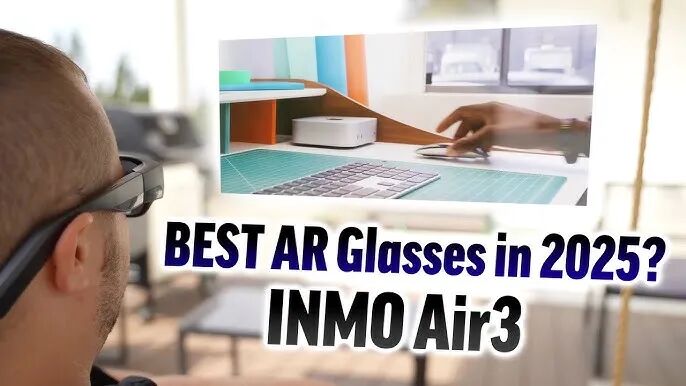Meta's New Product Points to Arrayed Waveguide Triumph: Is INMO the Undercover 'Visionary'? The October 16th Launch Event Could Reveal a Game-Changer
![]() 09/22 2025
09/22 2025
![]() 597
597
At 8 a.m. Beijing time on September 18th, the much-anticipated 2025 Meta Connect Conference finally kicked off as planned. Mark Zuckerberg, donning the new Ray-Ban Meta glasses, live-streamed his arrival, instantly setting the tone for the entire event. During the conference, Zuckerberg officially unveiled a slew of new products.
In line with the video content that had leaked online earlier, this launch featured an upgraded version of the standard Ray-Ban Meta, a new model co-developed with Oakley specifically for sports - the Oakley Meta Vanguard, and Meta's first-ever smart glasses equipped with a display screen and display functionality. This display-enabled model continues the partnership with Ray-Ban and is named the Meta Ray-Ban Display.

Among these, the most attention-grabbing is undoubtedly the first consumer-grade smart glasses with a screen. Its standout feature is the monocular full-color display situated below the right field of view. This screen employs arrayed waveguide technology, supports a variable refresh rate ranging from 30Hz to 90Hz, boasts an overall resolution of 600×600 pixels, an angular resolution of 42 pixels per degree, and a brightness range spanning from 30 to 5000 nits, ensuring excellent visibility even in bright outdoor sunlight.

Despite a few minor hiccups during the launch event, it's undeniable that the Meta Ray-Ban Display remains an impressive AR+AI smart glasses product. As Meta's first smart glasses with genuine digital display capabilities, this product embodies Zuckerberg's vision of 'AI on the Face' - integrating ubiquitous AI assistants and information into real-world scenarios without disrupting users' daily routines.
However, the Meta Ray-Ban Display is essentially a work in progress. Last year, at the Connect Conference, Meta showcased its first self-developed AR glasses, Orion, which featured a full-color binocular display using waveguide technology, with a cost as high as $10,000.
For the Ray-Ban Display, Meta abandoned the extremely expensive full-color high-definition Micro LED display plus diffractive waveguide solution used in Orion, which is impractical for consumer products in the near term. Instead, it opted for a low-cost, high-brightness, high-resolution new (PIC) LCoS screen and arrayed waveguide solution.
Choosing arrayed waveguide represents a significant shift in Meta's display technology approach. Besides sharing the slim profile advantage common to waveguides, compared to the mass-produced surface relief grating diffractive waveguide, arrayed waveguide offers superior imaging performance, virtually no light leakage, and lower light loss. This reduces the power consumption of the optical engine and extends battery life. Meta's decision clearly signals the victory of arrayed waveguide technology - a direction that aligns perfectly with the unwavering technical path chosen by domestic manufacturer INMO Technology from the outset.
Interestingly, while Meta continues to emphasize 'AI + Fashion' and strives to expand the application scenarios of smart glasses, INMO not only achieved the global launch of the first mass-produced 1080P wireless all-in-one AR glasses, AIR3, last year but, according to the latest leaks, will unveil a brand-new product - INMO GO3 - on October 16th. This product represents a comprehensive upgrade in fashion design, battery life, and AI capabilities.
Consensus on Display Technology Path: Meta 'Reverses Course,' While INMO Leads the Charge
In fact, while most consumer-grade AR brands were still experimenting with optical solutions like BirdBath, INMO Technology early on identified waveguide technology (especially arrayed waveguide) as the key to achieving slim and everyday-usable consumer-grade AR glasses. It invested heavily in continuous development and mass production.
When launching the first generation of its AIR series, INMO explicitly adopted arrayed waveguide technology, a relatively advanced choice for consumer-grade AR glasses at the time.

INMO AIR
Subsequently, INMO didn't stop at the prototype stage but continuously iterated its arrayed waveguide-based products, overcoming mass production challenges. In 2022, INMO Technology officially announced the mass production and delivery of INMO AIR, marking the transition of its arrayed waveguide technology from the laboratory to large-scale production.
In 2024, INMO Technology introduced INMO AIR3, claiming it as the 'world's first mass-produced 1080P wireless all-in-one AR glasses.' Featuring a full-color binocular display, it offers more mature mass production, brightness control, and light transmittance, enabling users to obtain clearer virtual images in bright outdoor sunlight.

INMO AIR3
As a global leader in the XR field, Meta's technology path choices carry significant industry influence. After exploring other solutions (such as diffractive waveguide), Meta ultimately chose arrayed waveguide for its first consumer-grade product with a display, aligning perfectly with the path INMO Technology has adhered to since 2021. This strongly proves the high degree of foresight in INMO's technological layout three years ago.
INMO CEO Yang Longsheng stated that Meta's decision to return to the waveguide technology path further validates the technical advantages of arrayed waveguide in achieving 'slim appearance + immersive vision + privacy protection' for AR glasses. Regarding the monocular display, it is based on multiple considerations, including weight and the trade-off between technology and cost. Monocular display offers relatively lower costs in terms of optical solutions and power consumption control, making it a balanced choice.
He said, 'Considering application scenarios driven by demand, combined with the products Meta has launched, it's evident that they have been focusing on lightweight and all-day wearability. Of course, they also hold a relatively leading advantage in appearance, so they are more focused on meeting some core needs of current users.'
INMO GO3: Not Just About Fashion, but Technological Prowess
According to the currently leaked information, INMO's upcoming new product, INMO GO3, set for release on October 16th, will achieve dual upgrades in fashion attributes and technological experience. While Meta emphasizes the concept of 'Fashion + AI' in smart glasses, INMO GO3 seems to be taking this concept to an even higher level.
In fact, smart glasses have long been constrained by their 'tech-heavy appearance,' making it difficult to integrate into diverse daily outfits. According to product information leaked by bloggers, INMO GO3 offers multiple frame styles catering to different face shapes and usage scenarios. This way, it may truly fulfill the demand for 'smart glasses as everyday accessories.'
Meanwhile, according to INMO's relevant executive, in terms of hardware, addressing the industry-wide battery life concerns, INMO will also introduce new solutions, aiming to define the standard for 'all-day wearability' in smart glasses.
Regarding applications, based on officially disclosed information, GO3 will see significant upgrades from GO2. For instance, in translation capabilities, INMO GO2 currently supports over 40 online translation languages, and GO3 may expand this support further. Additionally, in terms of AI capabilities, INMO GO3 is expected to further enhance meeting and voice interaction functionalities.
It's worth mentioning that the previous-generation product, INMO GO2, does not feature a camera. However, in reality, real-time first-person video recording has become one of the primary demands of consumers today. Will the upgraded GO3 cater to this demand by adding a camera? We can eagerly anticipate the answer.
Industry Perspective: Technical Breakthroughs by Chinese AR Brands
Besides the release plan for INMO GO3, INMO's another product, AIR3, is also making strides in overseas markets.
It is reported that AIR3 is about to launch a crowdfunding campaign overseas. This product previously won multiple top media awards at IFA and garnered widespread attention from overseas tech bloggers. Many bloggers who had early access stated that AIR3 excels in display performance, wearing comfort, and AI capabilities, particularly surpassing expectations in terms of the 1080p resolution display clarity and the portability of its all-in-one design.

INMO's technology path and market strategy reflect a broader trend: Chinese AR brands are transitioning from technology followers to technology definers. In core technologies such as arrayed waveguide, Micro-OLED display, and AI interaction, Chinese brands have already gained the capability to compete on par with international giants.
Conclusion
Although INMO has not yet officially announced the detailed specifications and pricing of INMO GO3, based on the available information, this product is likely to become a new benchmark in the smart glasses field. Especially against the backdrop of Meta's shift to arrayed waveguide technology, INMO's accumulated technical and market experience will provide it with a first-mover advantage.
The October 16th launch event will reveal more details, including the final pricing, release date, and specific implementation of software features. The author speculates that INMO GO3 will continue INMO's affordable pricing strategy, potentially driving the widespread adoption of smart glasses among a broader user base.
By Qing Yueling
(All uncredited images in the text are sourced from the internet)






